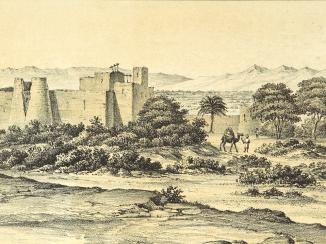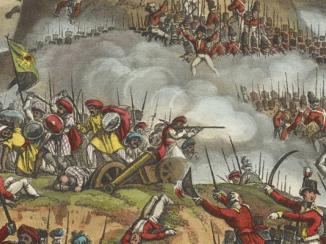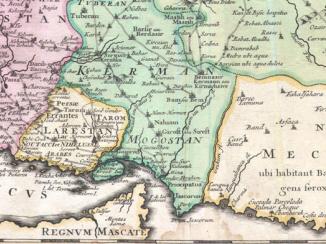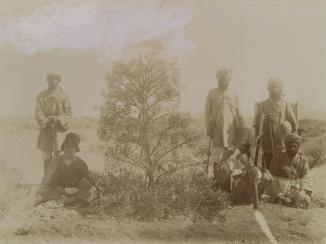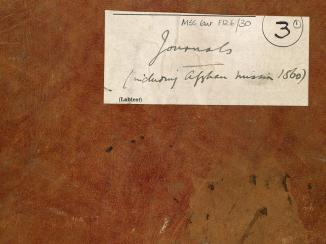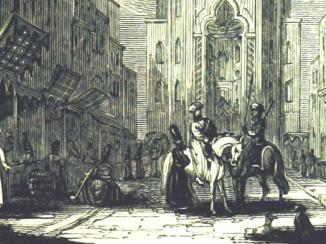Affairs in Persia and Herat
IOR/L/PS/5/476, ff 553-647
190 items in this record
Search within this record
The record is made up of 1 item (95 folios). It was created in 31 Mar 1853. It was written in English and French. The original is part of the British Library: India Office The department of the British Government to which the Government of India reported between 1858 and 1947. The successor to the Court of Directors. Records and Private Papers Documents collected in a private capacity. .
About this record
- Content
This part of the volume consists of a copy of an enclosure to a despatch from the Government of Bombay From c. 1668-1858, the East India Company’s administration in the city of Bombay [Mumbai] and western India. From 1858-1947, a subdivision of the British Raj. It was responsible for British relations with the Gulf and Red Sea regions. [Mumbai] Secret Department to the Secret Committee Pre-1784, the Committee responsible for protecting East India Company shipping. Post-1784, its main role was to transmit communications between the Board of Control and the Company's Indian governments on matters requiring secrecy. , Number 26 of 1853, dated 31 March 1853. The enclosure is numbered 3 and is dated 12 February 1853.
The enclosure is a letter from HM Envoy Extraordinary and Minister Plenipotentiary A diplomatic representative who ranks below an ambassador. The term can be shortened to 'envoy'. at the Court of Tehran, Lieutenant-Colonel Justin Sheil, to the Chief Secretary to the Government of Bombay From c. 1668-1858, the East India Company’s administration in the city of Bombay [Mumbai] and western India. From 1858-1947, a subdivision of the British Raj. It was responsible for British relations with the Gulf and Red Sea regions. , forwarding under a flying seal, to the address of the Secretary to the Government of India, copies of thirteen despatches addressed to HM Principal Secretary of State for Foreign Affairs, the Earl of Malmesbury, dated 8 January to 4 February 1853.
Sheil’s despatches to the Earl of Malmesbury consist of the following:
- No. 7, dated 8 January 1853: reporting that the Persian [Iranian] officer deputed to assume charge of the Government of Bender Abass [Bandar Abbas], pending the arrival of Mahomed Raheem Khan [(Haji) Muḥammad Rahīm Khān (Shirazī, Malik al-Tujjar)], the Governor nominated by the Shah, had been refused admission into that town by the authorities of the Imam of Muscat
- No. 8, dated 10 January 1853: reporting the death of Futtee Mahomed Khan [Fath' Muḥammad Khān], the Herat chief who had been in confinement at Beerjend [Birjand]. Sheil states that though a report has been spread that he committed suicide, there can be no doubt that he was killed on the orders of the Persian Government
- No. 12, dated 13 January 1853: in which Sheil states that it will be clear from the accompanying correspondence (some of which is in French) between the Sedr Azim [Sadr-i A'zam], his Russian colleague Prince Dolgorouki [Prince Dimitri Ivanovich Dolgorukov, Russian Minister to Persia], and himself, that his and Dolgorouki’s efforts to dissuade the Persian Government from collecting a large army at Sultaneyah [Soltaniyeh, also spelled Sultaniah in this item] in the ensuing Spring have been unsuccessful
- No. 13, dated 15 January 1853: enclosing a translated copy of letter from the Sedr Azim demanding that Great Britain should abstain from interfering in the affairs of Herat, and subsequent correspondence between Sheil and the Sedr Azim. Sheil expresses his opinion that if the British Government wishes to maintain influence and control over Herat, then this can be achieved only by excluding Persia altogether from Afghanistan and resisting the despatch of Persian troops to Herat on any pretext. Sheil suggests that the Persian Government could be urged to accept these conditions through British occupation of the island or Kharg (or Karrack)
- No. 14, dated 14 January 1853, reporting news including: the Sedr Azim informing Sheil that Syd Mahomed Khan [Sayyid Muḥammad Siddiq Khān Alakuzā'ī], the Ruler of Herat, has made an urgent appeal to the Prince Governor A Prince of the Royal line who also acted as Governor of a large Iranian province during the Qājār period (1794-1925). of Khorassan [Khorasan] for troops to aid in repelling Khohendil Khan [Kuhandil Khān Muḥammadzā'ī], who was advancing to the relief of Ferrah [Farah, also spelled Ferra in this item] (a letter from Syd Mahomed Khan to the Prince Governor A Prince of the Royal line who also acted as Governor of a large Iranian province during the Qājār period (1794-1925). is enclosed); that the Herat khans who had been brought under custody from Meshed [Mashhad] to Tehran, have been liberated, at least nominally; the Mission Agent at Meshed reporting that Syd Mahomed Khan continues to instigate the Toorkomans [Turkmen people] to make plundering expeditions into Candahar [Kandahar] and carry away numbers of Afghans into slavery
- No. 15, dated 14 January 1853: reporting that Meerza Saeed Khan [Mirzā Sa'īd Khān Ansarī], hitherto Persian Superintendent of Foreign Affairs, has been appointed Minister for Foreign Affairs
- A letter from Sheil to the Chief Secretary to the Government of Bombay From c. 1668-1858, the East India Company’s administration in the city of Bombay [Mumbai] and western India. From 1858-1947, a subdivision of the British Raj. It was responsible for British relations with the Gulf and Red Sea regions. , dated 15 January 1853, transmitting under a flying seal a copy of a despatch to the Earl of Malmesbury (No. 17, dated 15 January 1853) regarding a practice which is reportedly being carried out at Bombay of granting licences to Persian vessels to carry an ‘English’ flag, which they hoist in their own national ports (the despatch includes enclosed correspondence between Sheil and the Resident in the Persian Gulf The historical term used to describe the body of water between the Arabian Peninsula and Iran. , Captain Arnold Burrowes Kemball, and correspondence between the Resident and the Governor of Bushire [Bushehr], Mirza Hassan Ally Khan [ Mīrzā A title of honour originally applied to princes, later to military leaders, and later still to secretaries, chieftains, and other ‘gentlemen’. Ḥasan ʿAlī Khān]). Sheil requests any information on the subject from the Government of Bombay From c. 1668-1858, the East India Company’s administration in the city of Bombay [Mumbai] and western India. From 1858-1947, a subdivision of the British Raj. It was responsible for British relations with the Gulf and Red Sea regions. that would be useful for Lord Malmesbury
- No. 18, dated 15 January 1853: enclosing a copy of a despatch received from the Resident at Bushire, relating to certain proceedings of the Governor of Bushire, which Sheil fears may lead to ‘disorder’ in the Persian Gulf The historical term used to describe the body of water between the Arabian Peninsula and Iran. , and a translation a of letter which Sheil has addressed in consequence to the Persian Minister for Foreign Affairs. Sheil reports that a ship from the Persian port of Aseeloo [Asaluyah] had touched at Bushire, and the Governor of Bushire, Mirza Hassan Alee Khan, seized the Master and fined him twelve tomans 10,000 Persian dinars, or a gold coin of that value. , and also carried off a free Abyssinian [Ethiopian] sailor who was on board. Sheil states that the Chief (Governor) of Aseeloo, Sheikh Ahmed ben Kulfan [Shaikh Aḥmad bin Khalfān (Al Haram)], has threatened revenge against this aggression, and Sheil has intimated to the Persian Minister that private war cannot be carried out in the Persian Gulf The historical term used to describe the body of water between the Arabian Peninsula and Iran. (the despatch includes enclosed copies of Kemball’s correspondence with Sheikh Ahmed ben Kulfan and Mirza Hassan Alee Khan)
- No. 20, dated 19 January 1853: reporting that the Sedr Azim, instead of concluding the arrangement that had recently been reached regarding Herat, has sent Sheil another document which includes a clause stating that if Great Britain interfered at all in the affairs of Herat then the agreement would be annulled. Sheil states that he has rejected the proposed arrangements. (The despatch includes enclosed correspondence between Sheil and the Sedr Azim)
- No. 21, dated 22 January 1853: stating that a party of three khans of Herat who had been in confinement at Meshed had that day arrived at Tehran under restraint, but will probably be released soon, that one other khan had been murdered on the road by the Persian authorities, and that three other khans were still in confinement at Meshed
- No. 22, dated 30 January 1853: reporting news from the Agent at Meshed that Kohendil Khan, the Ruler of Candahar, had passed Ferra with 1,500 men and twelve guns, to proceed against Herat, and that Syd Mahomed Khan had sent a most urgent demand for aid to the Governor of Khorassan
- No. 23, dated 30 January 1853: enclosing further correspondence between Sheil and the Persian Prime Minister (Sedr Azim) regarding Herat, including: translated copies of an arrangement sealed by the Sedr Azim; a letter from the Sedr Azim to Syd Mahomed Khan notifying him of this arrangement; and a 'ferman' [ firman A Persian word meaning a royal order or decree issued by a sovereign, used notably in the Ottoman Empire (sometimes written ‘phirmaund’). ] from the Shah to Syd Mahomed Khan ratifying the arrangement
- No. 25, dated 4 February 1853: enclosing a translation of a letter from Sheil to the Ruler of Herat, transmitting to him a copy of the arrangement made by the Persian Cabinet concerning its future connection with his Government.
- Extent and format
- 1 item (95 folios)
- It is part of
- 1306 imagesRef: IOR/L/PS/5/476
- Arrangement
There is an abstract of contents of the despatch, numbered 1-3, on folios 553-554. The number 3 is repeated for reference on the verso The back of a sheet of paper or leaf, often abbreviated to 'v'. of the last folio of the enclosure.
- Written in
- English and French in Latin script
- Type
- Archival item
Archive information for this record
- Original held at
- British Library: India Office The department of the British Government to which the Government of India reported between 1858 and 1947. The successor to the Court of Directors. Records and Private Papers Documents collected in a private capacity.
- Access conditions
Unrestricted
- Archive reference
- IOR/L/PS/5/476, ff 553-647
- Former external reference(s)
- No. 26 of 1853
- Date(s)
- 31 Mar 1853 (CE, Gregorian)
Access & Reference
History of this record
Related search terms
- Subjects
- ShipsFlagsDiplomacyMilitary operationsHarboursImprisonmentHomicide
- Places
- SultaneyahBombayCandaharEmirate of HeratPersian GulfPersiaMeshed
- People & organisations
- Governor of AsaluyahMinister for Foreign AffairsImam of OmanGovernor of BushireRepresentative of the Russian Empire to PersiaPolitical ResidentPrime Minister to the Shah of PersiaSecretary of State for Foreign AffairsGovernment of PersiaHM Ambassador to IranGovernor of Bandar AbbasPrince-Governor of Khorasan
Use and share this record
- Share this record
- Cite this record in your research
Affairs in Persia and Herat, British Library: India Office Records and Private Papers, IOR/L/PS/5/476, ff 553-647, in Qatar Digital Library <https://www.qdl.qa/archive/81055/vdc_100129828648.0x000019> [accessed 8 July 2024]
- Link to this record
https://www.qdl.qa/en/archive/81055/vdc_100129828648.0x000019
- IIIF details
This record has a IIIF manifest available as follows. If you have a compatible viewer you can drag the icon to load it.https://www.qdl.qa/en/iiif/81055/vdc_100000000319.0x000123/manifestOpen in Universal viewerOpen in Mirador viewerMore options for embedding images
Copyright: How to use this content
- Reference
- IOR/L/PS/5/476, ff 553-647
- Title
- Affairs in Persia and Herat
- Pages
- 564r:564v, 568r:569r, 572r:572v, 577r:578v, 580r:580v, 584r:587v, 597v, 598v, 609v:610r, 615r:616r, 617r:619v, 628r:628v, 630r:631r, 634r:635r, 636r, 639r:639v
- Author
- Government of Persia
- Usage terms
- The copyright status is unknown. Please contact [email protected] with any information you have regarding this item.
- Reference
- IOR/L/PS/5/476, ff 553-647
- Title
- Affairs in Persia and Herat
- Pages
- 591r
- Author
- Sayyid Muhammad Khan Alakuza'i
- Usage terms
- Public Domain
- Reference
- IOR/L/PS/5/476, ff 553-647
- Title
- Affairs in Persia and Herat
- Pages
- 641r
- Author
- Qājār, Naser al-Din Shah
- Usage terms
- Public Domain
- Reference
- IOR/L/PS/5/476, ff 553-647
- Title
- Affairs in Persia and Herat
- Pages
- 553r:563v, 565r:567v, 569v:571v, 573r:576v, 579r:579v, 581r:583v, 588r:590v, 591v:597r, 598r, 599r:609r, 610v:614v, 616v, 620r:627v, 629r:629v, 631v:633v, 635v, 636v:638v, 640r:640v, 641v:647v
- Author
- East India Company, the Board of Control, the India Office, or other British Government Department
- Usage terms
- Open Government Licence






























































































































































































